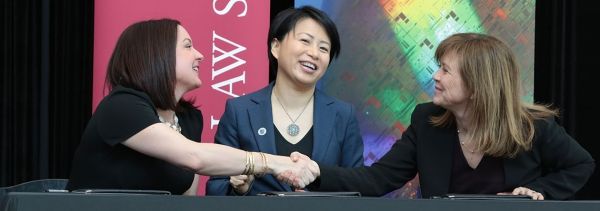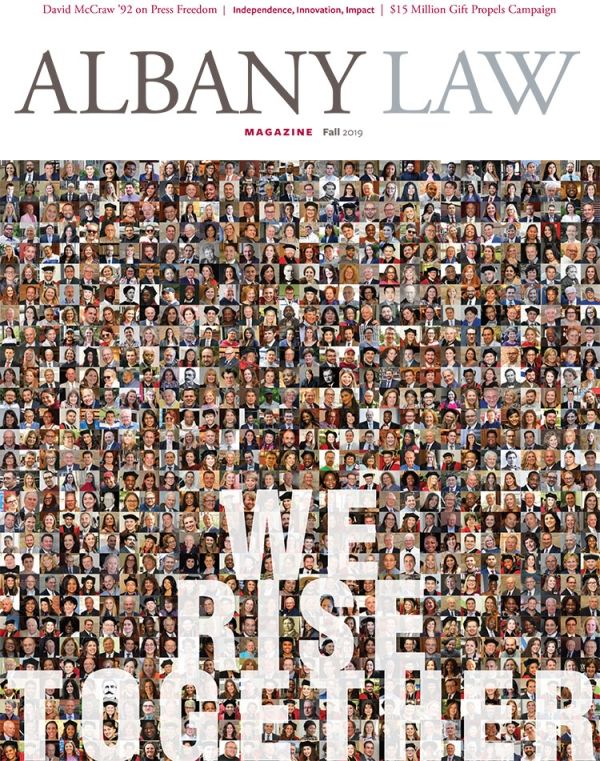Quantum Leap: Preparing Today to Handle the Innovations of Tomorrow

AS AN INTERN WITH THE RESEARCH FOUNDATION for the State University of New York (RF), second-year law student Joshua Pearlman ’20 worked with an engineering professor who invented a computer transistor capable of facilitating vast gains in processing power. Though not a science major, Pearlman quickly developed competency in quantum engineering—and the technology transfer process—and helped file a provisional patent for the invention.
Albany Law School is making these types of experiences possible through strategic partnerships with the RF, SUNY Polytechnic Institute (SUNY Poly), and other Capital Region institutions. Students can take advantage of in-depth and interdisciplinary educational programs designed to expose them to opportunities at the intersections of law, science and technology, business, and policy. The law school and the RF have cultivated a symbiotic relationship for 15 years, and students have benefited greatly, participating in the work of the Office of Industry and External Affairs (OIEA)—essentially the foundation’s legal office—through field placements, Semester in Practice, and the Innovation Internship program.
As the story goes, the connection started with one student, Heather Hage ’06, who interned at the RF in 2004—and never left. In her first year of law school, Hage was introduced to the person running technology transfer at the RF. He described what he did in technology commercialization, and she fell in love with the concept. She asked if she could work for him—for free, if necessary—and he agreed. Hage, who is one of five Albany Law alumni in her family, extended that internship through law school, and after graduating, continued on as a consultant until they created a position later that year that she filled. She has worked at the RF since and is now vice president of industry and external affairs.
More than 50 students—nearly half from Albany Law School—have followed in her footsteps. They have gained valuable experience at the RF, supporting the work of researchers and innovators across the SUNY system by providing assistance with all aspects of the technology transfer process, from protecting inventions through intellectual property (IP) law to finding ways to commercialize the work. “We help them translate their innovations into products and services that can touch people’s lives,” Hage said. “It’s truly ‘lab to market.’”
Each new intern is matched with an OIEA team member who can provide the appropriate experience, guidance, and mentoring based on the student’s interests and objectives.
Professor Ray Brescia, who coordinates the Semester in Practice program, explained how students at the RF learn not just the technology at the heart of these innovations, but the very process of innovation. They explore the patent process, learn how to do customer discovery, work on licensing agreements, research potential commercial applications for inventions, and help conduct market studies.
The OIEA gives interns full access to the entire operation, allowing them to work directly with researchers and attend industry events. “We create a very immersive experience here,” Hage said. “We also have an ‘open-chair policy’: if someone on staff is going somewhere—whether it be a client meeting or a conference in Washington, D.C.— anyone can go along.”
DURING PEARLMAN’S SEMESTER IN PRACTICE LAST FALL, his supervisor and mentor, assistant director for innovation services and former U.S. Patent and Trademark Office attorney Steven Wood, taught him about concept protection, market opportunity assessment, and commercialization strategies.
For one project, Pearlman was asked to produce a report on the state of quantum computing. The resulting 65-page document was made available to all who attended the inaugural Quantum Science and Engineering Workshop in November 2018. The workshop, hosted by SUNY, the Griffiss Institute, and the Air Force Research Laboratory’s Information Directorate, brought together more than 100 scientists from both academia and industry. “Quantum is the most counterintuitive way of looking at the world ever devised by scientists,” Pearlman said. “It is almost exclusively probability based—and everything has a non-zero probability of occurring.”
While difficult to wrap one’s mind around, quantum science has important potential applications. One is drug discovery, because testing requires thousands of computations based on complex 3D models. “Quantum computing, which relies on principles of quantum mechanics, can enable computing at exponentially higher speeds than current standards,” Pearlman said. Another is encryption. Current encryption uses random-number generators, but they are based on defined algorithms, so a powerful enough computer can eventually reverse-engineer those algorithms to come up with the key. By contrast, Pearlman explained, an intrinsic aspect of quantum anything is that it’s completely random. Using quantum key distribution, you can generate a truly random number—which makes it extremely hacker-resistant.
Pearlman continued working at the RF in what turned into a paid internship through the summer. He will earn dual J.D. and M.S. degrees in Intellectual Property Law and Bioethics next spring and has already started the job hunt, quickly landing interviews at IP firms. He believes that his experience at the RF is the key to his future. “It is how I leverage my skills, and what I talk to employers about,” he said. “Not only was it my door into the world of science-related law, it was particularly important for me, not having a hard science degree, to show potential employers that I am just as capable as students who do.”
SOME FORMER RF INTERNS have found jobs with technology companies in Silicon Valley, or in the case of Pabitra Chakrabarti ’17, in New Orleans as a patent attorney with GE Renewable Energy. Peter Evangelatos ’17 is an associate with Lando & Anastasi in Cambridge, Mass., where he practices IP litigation. And Hage is not the only former intern to have found a professional home at the RF. Matthew Mroz ’08 is its director of enterprise technology transfer, and Tanya Waite ’09 is partnerships manager.
“The exposure that students get to technology transfer and commercialization is excellent preparation for careers in technology and innovation,” Brescia said. “They gain an entirely new vocabulary and turn that into career opportunities.”
IN THE SPIRIT OF CONTINUAL IMPROVEMENT, Hage and Brescia discussed how to increase opportunities for students and expose them to the work of researchers in a more systematized way.
“The experiential component is the most powerful aspect of the program,” Hage said. “We wanted to take it to another level.” One way to do that is to immerse the students in a world-class research-and-development environment in which they can work with the developing technologies firsthand. Albany Law School and the RF joined with SUNY Poly in April to create an immersive experiential learning program in technology commercialization.

That program, the Innovation Intensive apprenticeship clinic, includes a new classroom component with a cohort structure and guest lecturers. “We can leverage our network to bring in entrepreneurs and people in government and industry,” Hage said. “These are people with deep subject-level knowledge who will talk about what they do, how they do it, and how it contributes to building better technology and a stronger economy.”
Students will still work on technology transfer projects through the RF, but there will be more opportunities for interdisciplinary collaborations with other students and faculty—as well as researchers, inventors, and entrepreneurs—in fields such as business, engineering, and computer science.
“Our goal is to break down walls between the tech and the legal sides, so that our students understand technology and can effectively counsel inventors and entrepreneurs because they understand the business side,” Brescia said. “And in return, the innovators will know how to communicate with their lawyers, who we hope will be our graduates.”
“Professor Brescia and I share a common vision and passion for exposing students to interdisciplinary opportunities at the intersection of law, business, science and technology, and policy,” Hage said. “We believe such experiences can be transformative and can develop a life of their own.”
Although the initial cohort is small by design, Hage anticipates growing the program to 40 students per year over the next five years. And with a partnership agreement now in place with SUNY Poly, Brescia expects that there will be more classes developed between the two institutions in the future, and perhaps even a collaborative degree program.
IN 2016, the law school welcomed a registered patent attorney with the U.S. Patent and Trademark Office who came with 12 years of private practice expe-rience representing clients on IP law matters. Professor Shahrokh “Seve” Falati was named director of programs for patents, technology transfer, innovation, and entrepreneurship.
He developed a new course called Entrepreneurship Law in Emerging Technologies (ELET), a hybrid class combining classroom teaching with interactions with clients on real cases. In his course, students travel to technology incubators and work in teams with technology entrepreneurs. The course is an example of one type of a “practice related opportunity” (PRO). Falati said PROs come in three forms, the first of which is getting experience meeting with and representing clients.
Students learn about their client’s technology and identify the issues that need addressing. They debrief with Falati after all meetings to reflect on what happened. “That’s how the students tend to learn best and they really enjoy it,” he said. “They can self-assess, and I can suggest what they might have missed or could have developed further.”
The second type of PRO is interacting with and learning from practicing lawyers who are doing IP work. Falati, who is president of the Eastern New York Intellectual Property Law Association, takes students once a month to meetings or events with members of the patent bar. At these meetings, they discuss the latest developments in the law and how those affect their work with clients. In April, they attended a joint function with the IP and Innovation American Inn of Court, at which 10 law students spoke with practicing IP lawyers and senior judges.
Falati also maintains a small law practice, which he uses to connect students to the industry. For example, one of his contacts, the inventor of Taggies baby blankets, was a guest speaker and a client for a pair of students who worked on her new idea. He also serves as a reference for his students, helping them land interviews and even job offers.
Learning on an international stage from practicing IP lawyers is the third type of PRO. “Technology development knows no boundaries,” Falati said.
“It’s interesting to talk to lawyers in different countries and learn how they are facing these issues in their own jurisdictions.” Last year, he and his Italian counterpart created a program at Università di Padova Law School called the Innovation and Technology Law Summer Academy. Participants have learned about the application of IP laws across borders in an international environment. They have exchanged ideas, networked across borders, and experienced Italian culture.

This year four Albany Law School students attended the innovation and technology law academy. Two stayed in Italy for the rest of the summer doing legal research on how IP laws affect the development of new technologies such as the platform that underlies Bitcoin-type cryptocurrencies.
Falati and the PROs offer a multi-faceted approach to preparing students for careers in IP law. One recent graduate, Joni Zucker ’19, experienced all aspects. She took the ELET course, attended functions with IP lawyers, and attended the summer program in Italy. With her well-rounded experience, she landed a prestigious fellowship at the U.S. Court of International Trade. “We’re seeing changes in technology every day,” said Falati. “The future is here—and our students are ready to take it on.”
PRINT ISSUE
Click for downloadable PDF

